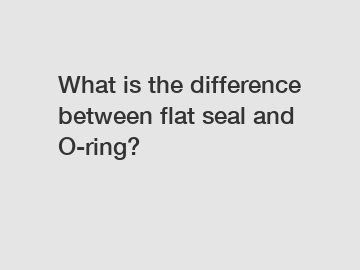Are you familiar with the different types of seals used in industrial applications? You may have heard of flat seals and O-rings, but do you know the differences between the two? Let's dive in and explore the characteristics of each type of seal to help you understand which one may be best suited for your specific needs.
Flat Seals.
Flat seals, also known as gaskets, are designed to create a tight seal between two flat surfaces. These seals are typically made of materials such as rubber, silicone, or metal, depending on the application requirements. Flat seals come in various shapes and sizes, including rectangular, circular, and oval, to accommodate different types of connections.

One of the key advantages of flat seals is their ability to seal large gaps between surfaces, making them ideal for applications where a tight seal is essential. Flat seals are commonly used in plumbing, automotive, and industrial machinery applications where there is a need to prevent leaks and maintain pressure.
O-Rings.
On the other hand, O-rings are circular seals with a round cross-section that are designed to fit into a groove and create a seal between two mating surfaces. O-rings are typically made of materials such as rubber, silicone, or Viton, which offer excellent resistance to chemicals, temperature extremes, and pressure.
The main advantage of O-rings is their ability to provide a secure seal in applications where there is limited space for a traditional flat seal. O-rings are commonly used in hydraulic systems, automotive engines, and industrial pumps due to their reliable sealing performance and versatility.
Differences Between Flat Seals and O-Rings.
1. Shape: The most noticeable difference between flat seals and O-rings is their shape. Flat seals are flat components that are placed between two surfaces, while O-rings are round seals that fit into a groove.
2. Sealing Method: Flat seals create a seal by compressing between two flat surfaces, while O-rings create a seal by deforming to fill the gap between mating surfaces.
3. Application: Flat seals are ideal for sealing large gaps between flat surfaces, while O-rings are best suited for applications where space is limited, and a secure seal is required.
4. Material: Flat seals and O-rings are made of different materials to suit the specific requirements of the application. Flat seals are generally made of rubber, silicone, or metal, while O-rings are commonly made of rubber, silicone, or Viton.
Which Seal Should You Choose?
The choice between a flat seal and an O-ring will depend on the specific requirements of your application. If you need to seal a large gap between flat surfaces, a flat seal may be the best option. On the other hand, if you have limited space and require a secure seal, an O-ring may be more suitable.
In conclusion, both flat seals and O-rings play essential roles in sealing applications, and understanding the differences between them can help you select the right seal for your specific needs. If you need further assistance in choosing the right seal for your application, feel free to contact us for expert advice. As a trusted supplier of sealing solutions, we are here to help you find the best seal for your needs.
For more information, please visit pu gasket, bakelite handles lever factory, pu polyurethane parts price.





Comments
0